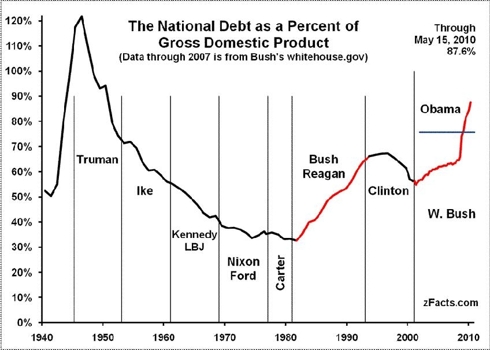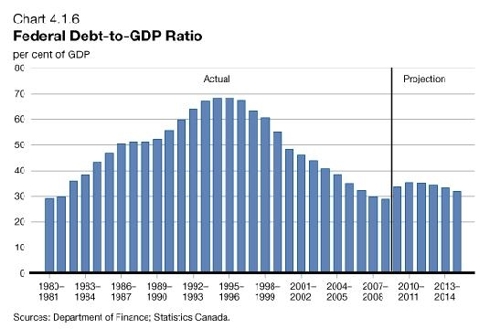Economy, Canada Indisposable Income and the Long Road Out of Debt
The Bank of Canada just doubled its overnight lending rate, to 0.5%, and became the first G8 country to do so since the Crunch. That came after a +6% growth rate in Q1 that brings Canada’s GDP to within 0.4% of its peak valuation, and strong employment gains in April. Of course the loonie dropped nearly a cent against the US$ after the rate hike was announced.
The rate hike wasn’t a surprise given the BoC had picked June as the likely point to reduce stimulus at the beginning of the year. Strong economic stats reinforced that likelihood for months. The bigger surprise was that very strong Q1 growth number, which is the largest quarterly jump in several decades. A big rebound quarter or two after a recession is normal, but is it sustainable?
Markets don’t seem to think so. One specific change is a slowing of the Canadian housing market which is focused in the most expensive Vancouver/Victoria and Toronto area markets. This came after a rule change requiring government sponsored mortgage insurance to be tested based on a buyer’s ability to maintain payments based on a 5-year fixed term rate. These have been several percentage points higher than floating rates. The move weeded out marginal buyers and lessened the want of others to go big.
Some dampening of demand was helpful given how quickly prices were pushing beyond usual affordability criteria in some markets. The other housing market of note to Canada’s economy has been the one in China. It too appears to be cooling in line with affordability concerns and efforts to keep that economy from overheating. The housing equation in China is different than in Canada however, and both are different than housing bubbles that developed in the US, Spain and some other former hot spots.
The bubbles that marked Decade One of the 3rd millennia were both overly indebted and overbuilt. Cheap debt pushed prices up despite the overbuild, hence forming a classic bubble.
Cheap debt was pushing up prices in Canada and especially in highly sought after areas. However, despite a healthy build being generated there is not yet evidence of an oversupply. It is true Vancouver and some other markets have a high percentage of overseas owners that don’t make much use of these second homes, but there’s little to suggest these are highly leveraged.
In China debt is less of an issue since mortgages are fairly new instruments that still require large down-payments. Well off urban Chinese who got in very cheap when privatization started have been pushing prices up through speculative second and third purchases. Government’s response to this has been to disallow mortgages on second homes in order to dampen speculation. Some oversupply has been generated in terms of current demand, but from an assumption of “build it and they will come”.
“They” are still coming to town from the countryside, but in smaller numbers and with less willingness to buy housing that is getting priced above their incomes. This doesn’t mean the Sino Sensation is over. It does appear to be going through a period of adjustment in what is arguably the mid point in its growth spurt. Nor does it mean millions are going to lose their savings in a housing bubble. Most of what has been built has also been paid for. Some speculators may wish they had funded something else, but of course that would be the point of reducing the ability to borrow to buy income housing.
That means we don’t expect the decline in copper and other base metals to end just yet. Growth in copper usage is heavily influenced by the infrastructure that goes with a housing boom. That’s not done in China. The question is when it will grow again. Stockpiles of copper have continued to decline, but at a slower pace. The copper price hit a 2010 low today, but it’s the stockpiles that continue to be our focus.
Gold continues to do well, and to be our real focus. Specifically, we continue to focus on companies that are putting more of it on the table through exploration. With a weak risk appetite it will be important to be selective, but gains should still be available.
As for the sustainability of Canada’s growth, we think sideways will be the theme. Those who bemoan current resource prices forget they are still 200-400% above levels of a decade ago. That is workable. Marginal house buyers will be alright if interest rates don’t continue to rise. For all the wrong reasons, we have to agree with the consensus that’s not an immediate issue.
Two Solitudes- The Long Road from Debt
Even if the European debt crisis doesn’t get worse, the stuff will need to get paid back at some point. What’s true for Europe is equally true for most of the world’s developed economies. This is not a short term problem or issue. Markets have been reeling the past few weeks based on a liquidity crisis and fear that markets could lock up again. In the longer term, solvency is the more serious issue to be tackled.
Countries with very high debt/GDP ratios are dependent on low interest rates, not just the good graces of bond vigilantes. To use a simplistic example; if a country has a 1:1 debt to GDP ratio then every 1% increase in interest on that debt adds the same amount (1% of GDP) to the current year’s deficit.
In reality, the interest rate only bites on new debt when it is issued or old debt when it is rolled over. That’s one reason there has been concern about governments’ shortening debt duration. The shorter the average duration, the quicker interest rate increases will be felt on a government’s bottom line.
The panic in Europe is not just about liquidity. It’s also about the bond market demanding yields that mean “the numbers don’t work anymore”. If Greece (or Portugal, or Spain or …) has its bond yields rise five percent that, in effect, adds five percent to the to the government’s annual deficit— forever —once its stock of debt has been rolled over. That’s unless the debt/GDP level, and ultimately the amount of debt, decreases.
This is a pretty dreary equation. It’s not surprising so many are so bearish now that people are focusing on it. For some countries it may indeed be impossible to make the numbers work. So far most of the real basket cases are, luckily, smaller economies. Restructuring the debt of Greece wouldn’t be fun or cheap for those picking up the tab, but it would be manageable. Its larger economies that are the real issue and the basis for fear.
We’re not laying this equation out because we have shares in an anti-depressant manufacturer. The real reason is to point out that some of the largest debtor nations are ones that can do something about it. It won’t be fun or fast, but it should be doable.
The two charts above show the debt/GDP ratio over time for the US and for Canada. Note that the Canadian chart is a shorter time frame, beginning roughly at the “Carter/Reagan” line on the US chart.
Unlike the US, Canada doesn’t have the benefit of the world reserve currency. When the Canadian federal debt/GDP ratio approached 70% in the late ‘80s the currency was getting hit. There was real fear of government bond auctions failing.
It was big news across the country and a major political issue of the day. Eventually, Ottawa brought in the GST, a VAT style tax that is a big revenue generator. The succeeding government followed that up with both spending cuts and additional tax surcharges. The GST came in at the start of 1991. People hated it, naturally, and the timing could have been better. The additional drag made a bad recession even worse and slowed the exit from it. Notwithstanding the other issues the PM had that introduced it, the political die was cast when GST came along.
A new government was elected on the promise of scrapping the GST. Ultimately the new cabinet backtracked and decided (rightly) it needed the revenues. Even with the GST it took several austerity budgets and plenty of screaming to finally start balancing the federal budget in the 1990s.
The Canadian and US debt/GDP ratios topped out in the mid 1990s at almost the same level, just below 70%. The ratio trended down through the late 1990s, but the Canadian decline was steeper because of both growth and the government running surpluses.
After 2000, the paths of the two countries diverged even more widely. The US cut taxes and ran up spending on several fronts while Canada continued to run surpluses until 2008. By the time the Credit Crunch began in earnest the US debt/GDP ratio was almost back to 70% while Canada’s was below 30%.
Currently, the ratio sits at about 37% for Canada and 87% for the US. Projections call for the gap to keep widening for at least a couple of more years.
Why are these two graphs so different? It’s not because Canada had better growth in the past 20 years, although it has been stronger in the past few. The real difference was attitude at both a governmental and social level.
- Company: HRA (Hard Rock Analyst) Newsletters
- Blog: hraadvisory.com
{{ commodity.name }}
{{ post.title }}
{{ post.date }}




Comments